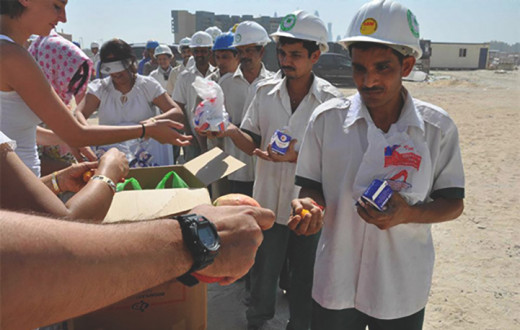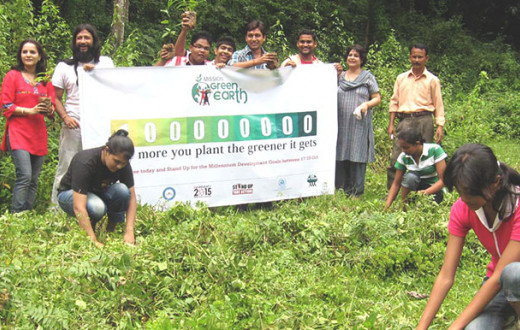Уметност на живеење, со своите корени во духовноста, има всадено длабока почит кон нашата планета кај илјадници луѓе низ целиот свет. Земјата можеби е составена од карпи, песок и вода, но духовноста може да ни помогне да ја согледаме нашата планета како жив динамичен ентитет, која ни враќа на нашата грижа и внимание.
Инспирирани од визијата на Гурудев Шри Шари Рави Шанкар и тимската создавачката енергија, волонтери од целиот свет иницираа неколку проекти за животна средина,меѓу кои се и големи насади на дрвјата преку мисијата Зелена Земја, управување и заштита на водата преку чистење на загадени и исушени реки и бесплатно земјоделство кое е и економично и органско здраво.
„Треба да ја заштитиме земјата. Дамнешните луѓе од целиот свет порано ја почитувале земјата, реките, планините и воздухот. Ние треба да ги задржиме овие антички вредности и да имаме модерна визија за развој и просперитет за сите„
~ Шри Шри Рави Шанкар
Влијание:
71 милиони дрвја
засадени со неколку еко-пријателски иницијативи за околината
9.6 милиони дрвја засадени
во 36 земји и во над 26 индиски држави како дел од мисијата Зелена Земја.
27 реки
течат низ 4 индиски држави благодарение на проектите за зачувување на вода и заживување на реките
Над 2,000,000 земјоделци и рурални млади фармери
обучени за Шри Шри природно земјоделство
40,310 завршени акции за расчистување на ѓубрето
Над 15,000 тоалети
обезбедени и поставени на оддалечени места.
Позначајни проекти
- Going Green
- Effective Water Management
- Cleaning Precious Water Resources
- Flowers to Compost
- Spreading Natural Farming Practices
The Art of Living launched ‘Mission Green Earth’ on a massive scale in collaboration with the United Nations Millennium Campaign (UNMC) and the United Nations Environment Program (UNEP). In a very short time, ‘Mission Green Earth’ raised the planet’s tree count by 10.6 million. Thanks to scores of volunteers the world over who are protecting and planting indigenous trees. In fact, their huge numbers rival the number of trees planted! Making this endeavor one of the biggest fights against global warming.
The Art of Living runs multiple initiatives to conserve (e.g. water harvesting, river cleaning) as well as increase fresh water supply sources (e.g. river rejuvenation).
27 Rivers in India Brought to Life
Currently, 22 rivers and tributaries are being revived in Maharashtra, India. The bleak backdrop of frequent droughts, crop failure, and farmer suicide has metamorphosed into hope and abundance. With more water available, farmers are able to sustain farming, buy equipment, purchase more seeds, grow water-intensive crops and look forward to life.
How did this happen?
- A multi thronged approach was adopted.
- Tank water was mobilized to provide relief to remote drought areas.
- Funds raised to clean, deepen and widen existing rivers, lakes and canals.
- Massive amounts of silt removed from river beds. Then layered over neighboring fields to boost fertility.
- Ground water recharged.
- Rainwater harvesting done.
- Workshops conducted to re-educate farmers to fall back on traditional methods of farming
- Community involvement nurtured and developed
“Since my childhood, I’ve never seen so much water in the nalla (canal) and in my farm well.”
Pandurang, farmer from Maske Village, Latur, Maharashtra
“I used to go for swimming in this river when I was young. But for the last 20 years we used to say that there used to be a river here. But this year, I can enjoy swimming in the river again.”
Ramkishan Savant, a retired school teacher
“Our village had been facing a water problem for the last 15 years. We didn’t even have drinking water on our side of the village. We were forced to grow crops like tomatoes and millets, which do not fetch much money. Now we have started growing rice. Next year, we plan to cultivate wheat and sugarcane. I now see 30 feet of water in my 45 feet deep well. It was parched for the last three years. This is a huge step forward.”
Farmer Balaram, Vellore, Tamil Nadu
"We have always used the water from the holy rivers like Ganga and Yamuna to purify ourselves, but today we have reached a point where we have to purify this water. So, we are waging a war against pollution in our rivers. The government alone cannot do it. We will have to come together."
~ Gurudev Sri Sri Ravi Shankar
Back in 2010, The Art of Living mobilized thousands of citizens for the Clean Yamuna drive (Meri Dilli, Meri Yamuna) in Delhi. Contributing significantly to the city’s readiness for the Commonwealth Games in October 2010.
In 2015, the filth in the Godavari in Maharashtra was mopped up under the Mazi Godhi, Mazi Aai Godavari river clean up.
The Pampa cleaning project was launched in April 2014 Pampa. Pampa is the third longest river in Kerala, India and is revered as the ‘southern’ Ganga.
Pampa Highlights:
- 600 tons of garbage removed
- 68,800 volunteer hours spent on the project
- 30 lakh people sensitized through direct interaction
- Over 8000 volunteers from 14 districts involved
- 377 school children and staff from 8 Sri Sri Ravi Shankar Vidya Mandir schools participated in the initiative
In India, Hinduism alone boasts 330 million gods and goddesses! Not exactly a small number. And with so many deities to appease and worship, one can only guess at the mind boggling number of flowers offered up! Generating a colossal amount of waste the very next day. The issue needed addressing and it was. ‘Converting temple flower waste to compost’ was initiated by the Sri Sri Rural Development Program Trust in partnership with the major temples of India.
By 2017, The Art of Living plans to set up 40 SWM plants in temples across India.
- · Dec 2015: 1,241 kg temple waste was converted into 414 kg compost
- · Jan 2016: 3,000 kg temple waste was turned into 1114 kg compost
The Art of Living has launched training programs to encourage farmers to return to traditional methods of natural farming. Eliminating the use of harmful chemical fertilizers and pesticides.
More than 2,000,000 farmers across India, including those in Maharashtra, Madhya Pradesh, and Rajasthan now have the expertise to resuscitate soil fertility and the bounty of their crops.
“Natural farming can drastically reduce the cost of production. The production cost of chemical farming is exorbitant. For example, if a farmer is growing pomegranate on one acre of land, his expenditure through chemical farming techniques would be Rs. 100,000. On the other hand, the production cost of pomegranate on one acre of land through natural farming techniques would be only Rs. 5,000.”
Ashok Sabade, natural farming trainer.
“I started farming around 20 years ago. I was completely dependent on chemicals. Around 8 years ago, I was introduced to organic farming by The Art of Living. Since then, I have been following it 100 percent with full confidence and great results.”
Shashikant Salunkhe, a farmer from Maharashtra








